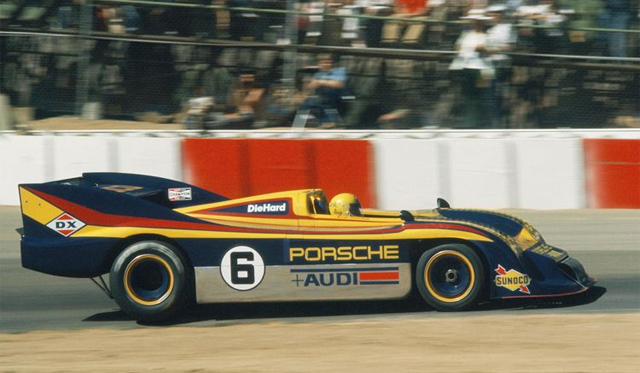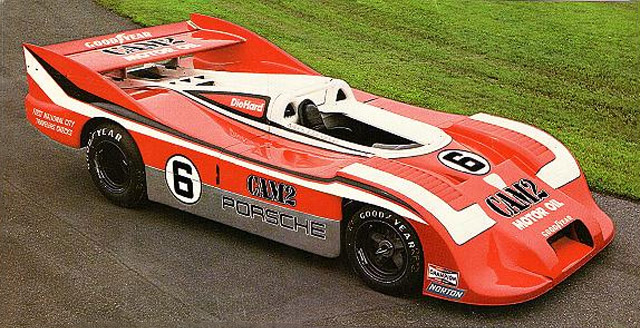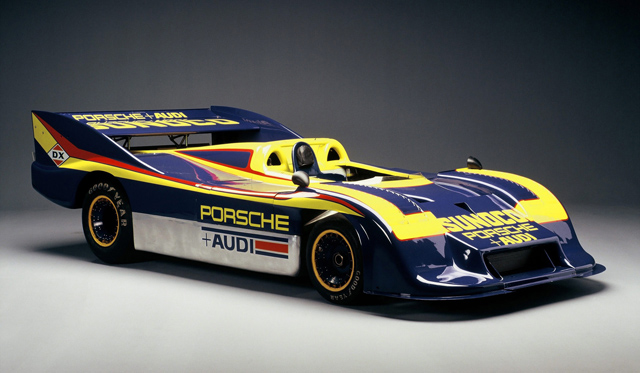
The Porsche 917 is one of the most infamous racing cars made by Porsche. Fast and powerful, this was the car which gave Porsche its first overall wins at the 24 Hours of Le Mans in 1970. The following year a streamlined 917 dominated Le Mans where it drove a total of 5,335.km, an overall distance record that stood until 2010. In total the 917 won 14 of the 21 races in the World Sportscar Championship in which it was entered. No other car could compete. This forced the FIA to change the rules and simply said after 1971 the Porsche was no longer welcome in the World Sportscar Championship — Porsche’s racing car became a victim of its own success.
The 917 had already conquered the circuits in Europe, so Porsche decided to focus on the North American markets by entering the Can-Am Challenge, known for its “anything goes” philosophy. The regulations were minimal and permitted unlimited engine sizes, turbo and supercharging were allowed, and there were virtually no restrictions on aerodynamics.
Can-Am races were run over a distance of 200 miles (320 km) in Canada and America, hence its name Canadian-American Challenge (abbreviated to Can-Am). A topless Porsche 917PA Spyder had already competed in the popular racing series in 1969 and 1971, but not with full support of the factory. This changed in the 1972 when Porsche joined forces with American team-owner Roger Penske and the experienced racing driver Mark Donahue.

Porsche experimented with a 7.2-liter flat-sixteen engine, but eventually the Germans opted for a 5.0-liter turbocharged twelve-cylinder engine to be used in racing. Penske entered the 1972 season with two Porsche 917/10s with Mark Donahue and George Follmer as their drivers. Testing commenced and immediately Donahue drove his Penske-Porsche around the track in record times. The Porsches would become more and more successful during the season, and at the end Follmer was crowned as champion.
The following year Porsche entered the series with the same drivers, but with a new car: the 917/30 Spyder which would become the most powerful sports car ever raced. Its 5.4-liter twelve cylinder engine charged with two exhaust turbochargers provided 1100 horsepower and 1100Nm of torque. Quite impressive — especially considering the fact the 917/30 Spyder weighed only 800kg — but in qualifying trim the engine was tickled up to an astonishing 1580 hp.
The Porsche flat-twelve was the first engine in racing with a four-figure horsepower. The great reservoir of power allowed the car to sprint to standstill to 100 km/h in 2.1 seconds, while 200 km/h was reached in 5.3 seconds and 300 km/h was hit in 11.3 seconds. Its top speed of 385 km/h is impressive as well. The 1973 Can-Am season seemed like a walk-over as the Porsche 917/30 won every single race and Donahue became champion and Follmer second.
In October 1973 the world was hit by an oil crisis, fueled by tensions in the Middle-East. The lack of oil had a huge impact in the world economy and politics, and it also influenced racing. Can-Am rules were changed: a fuel efficiency restriction was imposed — according to some to help the competition — and Porsche subsequently withdrew from the “anything goes” racing series. Just like in the earlier years in the World Sportscar Championship, the only car capable of beating the 917 seemed to be the car itself.

In the Summer of 1975 Mark Donahue took a modified 917/30 (pictured above) to the Alabama International Motor Speedway — nowadays better known as the Talladega Superspeedway — in an attempt to break some records. Donahue drove the Porsche around the 4.28-km long (2.66-mile) high-speed track with an average speed of 355.85 km/h (221.1 mph). This was a new world record, it was the highest average lap speed ever achieved on any circuit in the world. Donahue’s top speed on Talladega’s straight was an amazing 413.6 km/h (256 mph).
This record marked a fitting farewell to the 917 Can-Am racing car, which was so powerful and successful, that some even claim it was the car that killed Can-Am racing. Although this claim is a bit exaggerated as it ignores the oil crisis and dwindling interest, it’s also a testimony to the legend that one of the most powerful cars ever made had become.

















I saw this monster race at Road Atlanta in 1973. By then McLaren had withdrawn and the 917/30 had no real competiton but it was fun to watch it blow all the 917/10s every one else was racing off the track. My understanding at the time was that the oil crisis was a convenient excuse to make a rule that would make the 917/30 obsolete. By the way, the 917 motor is a flat 12, rather than a "V" configuration.